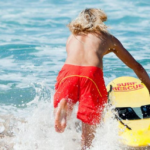
The History of IronMan Surf Life Saving and the Coolangatta Gold
While the Surf IronMan and Surf IronWoman events are the ultimate test of speed, skill, courage, and endurance, the Coolangatta Gold is one of the most challenging endurance races in surf sports.
Both events are now iconic, with hundreds of entries from people keen to push their limits and stay fit. Keep reading to learn more about the Surf IronMan and the Coolangatta Gold.
Swim between the flags
Surf Life Saving Australia is the humanitarian aspect and organisation behind the IronMan race since the 1920’s. While the modern competition is fierce and no longer part of current practice of surf lifesaving, it allows lifesavers to practise their skills, improve their fitness, and honour teamwork, friendship and traditions of surf lifesaving.
The origins of IronMan
In the 1950s, the IronMan race kicked-off in Australia and the United States. In 1956, competitors from around the world, including Australia and New Zealand, South Africa, and America, participated in the first series of swimming, boarding and ski races at Collaroy Beach, NSW. The event gained traction in 1966, when the event was then incorporated into the Australian Surf Life Saving Championships. From then on, IronMan was a way of stimulating enthusiasm in the work of surf life-saving.
It’s important to note that the IronMan should not be confused with the Ironman Triathlon event (2.4-mile swim, a 112-mile cSport events have always been part of the Australian lifestyle, especially on the Gold Coast — from the Commonwealth Games to the IronMan and the Coolangatta Gold events.ycle, and a 26.2-mile run). The triathlon is more of a lower-body sport, while the IronMan race focuses mainly on core and upper-body strength. Technical surf skills required for IronMan are also different to the ones required for a triathlon.
What’s the IronMan series about?
The athletes who take part in the IronMan are the elite of surf sports. The race typically lasts for 40-50 minutes in total, and to win, IronMan and IronWoman participants must be impeccable in four disciplines: swimming, running, surf ski paddling, and board paddling.
Competitors have to complete two or three circuits of the course, transitioning constantly between board, ski, swim, and run. While it’s obvious each competitor has a preference or strength in a certain discipline, ultimately the winner of IronMan is the one that’s able to alternate between the four successfully, keeping the pace.
-
The swim leg: Competitors run into the ocean from the beach and through the surf zone by wading, duck-diving and dolphin-diving under and over waves, until they reach deep water and can begin swimming freestyle.
-
The board leg: Competitors race through the surf and ocean on racing mal paddle boards – these are a three-metre-long fibreglass or carbon fibre boards with a foam core.
-
The ski leg: Competitors paddle six-metre-long skis that weigh up to 20kg. Long skis are similar to a regular kayak, however they are longer and narrower.
-
The run: The run leg is done over the beaches’ soft sand, and this component is used to transition between each of the other race legs. Each second is vital to defeat opponents.
The birth of IronWoman
Women were finally added to the Surf Lifesaving race in the early 90’s. At first, women were only allowed to compete in the swim, run and board legs, with the female ski leg being added several years later.
The Coolangatta Gold
Another race that happens yearly on the Gold Coast is the Coolangatta Gold — one of the most challenging endurance races held in Coolangatta’s best surf sports. The iconic race started 30 years ago, and it runs every October in Coolangatta Beach. The Coolangatta Gold consists of a 41.8-kilometre long course race, or the 21-kilometre short course, which features ski paddling, swimming, board paddling, and running. Participants may enter as an individual or as a team.
The long course
A course specifically made for the endurance surf race participants willing to race for a full 41.8km — stretching from the Gold Coast strip from Coolangatta to Broadbeach, challenging the competitor’s abilities and pushing them to their physical and mental limit.
The short course
Don’t let the name fool you — it’s short, but far from easy! The short course is comprised by 21km of surf sports endurance action and ends in Coolangatta Beach — allowing for increased engagement with fans and a great atmosphere.
Youth challenge
The youth challenge is an event is specially designed for the aspiring lifesavers and future ocean and beach event competitors. Those who are between 10 – 16 years old and are keen for the challenge of a lifetime are encouraged to try the youth challenge. The course consists of a 300m soft sand run, 400m swim, 400m run, 500m board and a 50m run to finish with.
Enjoying the surf on the Gold Coast
The stunning Gold Coast coastline provides the perfect setting to get some exercise done — and the IronMan and the Coolangatta Gold races are iconic sport events that make the most out of it in beautiful Gold Coast. If you’re watching the races on the Gold Coast, be sure to head to The Strand Coolangatta to experience dining, shopping, and to see what’s on.

